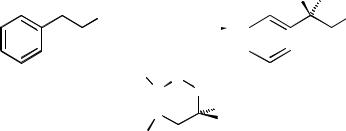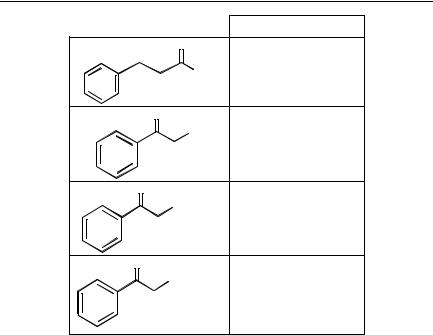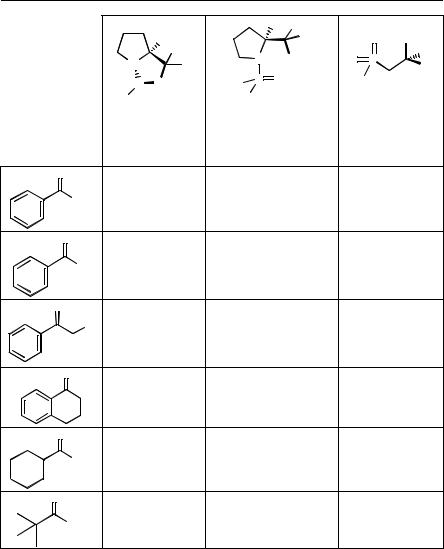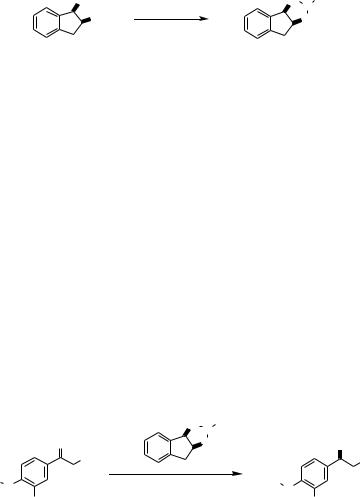
Roberts S.M., Poignant G. - Catalysts for fine chemical synthesis (Vol.1) (2002)(en)
.pdf
asymmetric reduction using nonmetallic catalysts |
149 |
.Oxazaphosphinamide (N-(di-p-anisylphosphoryl)-(S)-a,a-diphenyl-2-pyr- rolidine methanol), 50mg, 0.1mmol, 0.1eq*
The catalyst was prepared by reaction of (S)-diphenylprolinol with dimethylphosphinite and triethylamine in the presence of carbon tetrachloride. The N-(O,O-dimethylphosphoryl) derivative obtained was treated with an excess of p-anisylmagnesium bromide to give the oxazaphosphinamide
catalyst[13].
. Borane dimethyl sulfide complex 2 M solution in tetrahydrofuran, 0.5mL, 1mmol, 1eq
. Petroleum ether, ethyl acetate, triethylamine
. Saturated aqueous solution of NH4Cl, 10mL
. Brine
. Magnesium sulfate
. Silica gel 60 (0.063±0.04mm)
. p-Anisaldehyde dip
. 50mL Two-necked dry round-bottomed flask with a magnetic stirrer bar
. Magnetic stirrer hot plate with a thermostatically controlled oil bath and thermometer
. Dean and Stark apparatus
. Condenser
. Syringe, 3mL
. Syringe pump
. Separating funnel, 250mL
. Rotary evaporator
. Kugelrohr apparatus
Procedure
1.A 50mL two-necked round-bottomed flask (dried overnight at 1508C and cooled under vacuum) was equipped with a Dean and Stark apparatus and flushed with nitrogen.
2.The flask was filled with the catalyst (50mg) and anhydrous toluene (4mL). The mixture was refluxed until 3.5mL of solvent was recovered. The catalyst was azeotroped twice with toluene (4mL) and then cooled to room temperature under argon.
Precautions were taken whilst azeotroping the catalyst with toluene: thus the use of freshly dried toluene and flame-dried glassware were necessary to ensure anhydrous conditions.
3.The Dean and Stark apparatus was removed, replaced by a condenser (the solution was flushed continuously with nitrogen) andthe catalyst dissolved in anhydrous toluene (2mL). Borane±dimethylsulfide (0.5mL of a 2M solution in tetrahydrofuran) was added to the mixture, which was heated to 1108C.
* The catalyst was kindly provided by Prof. M. Wills (University of Warwick, Coventry, UK).
150 |
hydrolysis, oxidation and reduction |
4.When the reaction was at reflux, a solution of chloroacetophenone (154 mg) in toluene (2 mL) was added via a syringe pump over 10 minutes. After completion of the addition the reaction was stirred for a further 20 minutes.
5.The reaction was followed by TLC (eluent: petroleum ether±ethyl acetate; 85:15). The chloroacetophenone was UV active and stained grey with p- anisaldehyde dip, Rf 0.5. 2-Chloro-1-phenylethanol was UV active and stained green-grey with p-anisaldehyde, Rf 0.39.
6.The mixture was cooled to room temperature and the borane±dimethylsulfide was slowly hydrolysed by water (10 mL) and then by a saturated solution of NH4Cl (10 mL).
7.The mixture was transferred into a separating funnel and the two phases were
separated. The aqueous layer was extracted with ethyl acetate (2 30 mL). The combined organic layers were washed with water (3 30 mL), brine (3 30 mL) and then dried over magnesium sulfate, filtered and concentrated to give a crude oil (620 mg).
8.The crude material was purified by flash chromatography on silica gel (30 g) using petroleum ether±ethyl acetate±triethylamine (89:10:1) as eluent to give
2-chloro-1-phenylethanol as an oil (140 mg, 90 %).
The ee (95 %) was determined by chiral GC (Lipodex1 E, 25 m, 0.25 mm ID, temperatures: column 105 8C isotherm, injector 250 8C, detector 250 8C, mobile phase helium). Rt (R)-enantiomer: 102.4 min; Rt (S)-enantiomer:
106.7 min.
1H NMR (200 MHz, CDCl3): d 7.39±7.31 (m, 5H, Ph); 4.88 (ddd, J 8.8 Hz, J 3.3 Hz, J 3.3 Hz, 1H, CH); 3.74 (dd, J 3.3 Hz, J 11.5 Hz, 1H, CHaHb); 3.70 (dd, J 8.8 Hz, J 11.8 Hz, 1H, CHaHb); 2.78 (br s, 1H, OH).
IR (CHCl3, cmÿ1): 3586, 3460 (O±H), 3070, 3012, (C±H Ar), 2961, 2897 (C±H aliphatic), 1603 (Ar), 1494, 1454 (Ar), 1428, 1385, 1254, 1187, 1062, 1012, 870, 690.
Mass: calculated for C8H9OCl: m/z 156.03419, found [M]‡ 156.03385.
Conclusion
The reduction using the oxazaphosphinamide is easy to reproduce and the results correlate with the published material. During the reaction the addition of the chloroacetophenone solution needs to be as slow as possible; this is an essential factor for obtaining a good enantiomeric excess. According to the publication, the reaction could be performed without the prescribed precautions to work under anhydrous conditions with only a small drop in selectivity and no change to the reaction time. This is due to the stability of the phosphinamide reagent, which is not sensitive to water or oxygen. Another advantage of using this catalyst is that it does not decompose under the reaction conditions and could be recovered and re-used without any decrease in the reactivity. In Table 11.2 different results obtained by oxazaphosphinamide catalysts are reported. Some other examples are given in Table 11.4.

asymmetric reduction using nonmetallic catalysts |
151 |
Table 11.2 Reduction of aromatic ketones using oxazaphosphinamide catalyst[13] (results according to the literature).
|
|
Yield % |
ee % |
|
O |
|
|
|
CH3 |
89 |
90 |
H3CO |
|
|
|
|
O |
|
|
|
CH3 |
82 |
90 |
|
O |
|
|
X |
Cl |
X = H; 8 |
94 |
|
|
X = CH2OBn; |
93 |
BnO |
|
84 |
|
|
|
|
|
|
O |
|
|
|
|
83 |
>90 |
|
O |
|
|
|
O |
|
|
|
|
71 |
>90 |
|
O |
|
|
11.4ASYMMETRIC REDUCTION OF CHLOROACETOPHENONE USING A SULFOXIMINE CATALYST [S]
11.4.1PREPARATION OF b-HYDROXYSULFOXIMINE BORANE
O |
NH |
BSA,CH3CN |
O |
NSiMe3 |
n-BuLi |
O |
|
NH HO |
|
|
|
||||||
|
|
|
|
|
|
|
Ar |
|
|
S |
|
|
S |
|
|
S |
|
|
|
|
O |
|
|
|||
Ph |
CH3 |
50 8C |
Ph |
CH3 |
|
|
Ar |
|
|
Ph |
|
||||||
|
|
|
||||||
|
|
|
|
|
|
|
|
|
|
|
|
|
|
Ar |
Ar |
|
|
Materials and equipment
. (SS)-Methyl-S-phenylsulfoximine, 523mg, 3.4mmol*
* (SS)-Methyl-S-phenylsulfoximine was kindly provided by Prof. C. Bolm (Technische RWTH Aachen)
152 hydrolysis, oxidation and reduction
. N, O-Bis-(trimethylsilyl)-acetamide (BSA), 924mL, 3.74mmol, 1.1eq
. Dry acetonitrile, 15mL
. Dry tetrahydrofuran, 18mL
. n-Butyl lithium, 1.6 M in hexane, 2.1mL, 3.4mmol, 1eq
. Benzophenone, 682mg, 3.74mmol, 1.1eq
. Aqueous saturated solution of NH4Cl and methanol (10:1), 2mL
. Petroleum ether, ethyl acetate
. p-Anisaldehyde dip
. Silica gel 60 (0.063±0.04mm)
. 50mL Two-necked round-bottomed flask with a magnetic stirrer bar
. 50mL Schlenk tube with a magnetic stirrer bar
. Condenser
. Cannula (double-tipped needle)
. Magnetic stirrer hot plate with a thermostatically controlled oil bath and thermometer
. Ice-bath
. Syringe
. Solid carbon dioxide/ethanol cooling bath (ÿ788C)
. Kugelrohr apparatus
Procedure
1.A 50mL two-necked flask equipped with a magnetic stirrer bar was dried overnight at 150 8C, cooled under vacuum and flushed with nitrogen.
2.Under a nitrogen atmosphere, the flask was charged with (SS)-methyl-S- phenylsulfoximine (523mg) and placed under vacuum. The flask was flushed with nitrogen, then dry acetonitrile (15mL), and N, O-bis-(tri- methylsilyl)-acetamide (924 mL) were added.
3.The flask was equipped with a condenser and the mixture was heated under nitrogen at 508C and stirred for 45 minutes at this temperature (it was not necessary for the solvent to reflux).
4.After 45 minutes, the mixture was cooled to room temperature under nitrogen. The solvent was evaporated under high vacuum.
5.The residue was placed under nitrogen in a Kugelrhor apparatus and the impurities were distilled at a temperature less than 708C at 0.3mbar. The purity of N-(trimethylsilyl)-S-methyl-S-phenylsulfoximine was verified by NMR.
. 1H NMR(200MHz,CDCl3): d 7.97±7.93 (m, 2H, Ph); 7.57±7.451 (m, 3H, Ph); 3.01 (s, 3H, CH3); 0.11 (s, 9H, Si (CH3)3).
6.A 50mL Schlenk tube equipped with a magnetic stirrer bar, dried overnight at 1508C, was cooled under vacuum and then flushed with nitrogen.
7.N-(Trimethylsilyl)-S-methyl-S-phenylsulfoximine (prepared as above) was dissolved in 15mL of dry tetrahydrofuran and transferred by cannula into the Schlenk tube under nitrogen.

asymmetric reduction using nonmetallic catalysts |
153 |
8.The mixture was cooled to 0 8C with an ice-bath and then 2.1 mL of n-BuLi (1.6 M in hexane) was added carefully via a syringe. The solution became yellow.
9.The mixture was cooled to ÿ78 8C using an ethanol cooling bath. A
solution of benzophenone (682 mg) in dry tetrahydrofuran (3 mL) was then added dropwise. The mixture was stirred for 2 hours at ÿ78 8C.
10.The reaction was followed by TLC (eluent: petroleum ether±ethyl acetate; 9:1). The benzophenone was UV active and stained yellow with permanganate, Rf 0.58. b-Hydroxysulphoximine was UV active and stained yellow with p-anisaldehyde, Rf 0.11.
11.The reaction was quenched with aqueous saturated solution of NH4Cl and methanol (10:1, 2 mL). The mixture was stirred overnight at room temperature and the solvent was evaporated under reduced pressure.
12.The alcohol was obtained by flash chromatography on silica gel eluting with petroleum ether±ethyl acetate (9:1) to eliminate the benzophenone and then with an eluant ratio 6:4, giving (SS)-1,1-diphenyl-2-(S-phenylsulfoni- midoyl)-ethanol (790 mg, 2.3 mmol, 77 %).
. The yield of the reaction is variable (33±77 %), especially if the reaction is not carried out under strictly anhydrous conditions or if the flash chromatography takes an excessive amount of time.
. 1H NMR(200 MHz, CDCl3): d 7.6±7.09 (m, 15H, Ph); 4.11 (s, 2H, CH2);
2.96(br s, 1H, NH).
11.4.2 REDUCTION OF CHLOROACETOPHENONE USING THE SULFOXIMINE BORANE
O |
|
|
|
|
|
|
|
|
|
|
H |
OH |
||||
|
|
Cl |
BH3:SMe2 |
|
|
|
|
|
Cl |
|||||||
|
|
|
|
|
|
|
||||||||||
|
|
|
|
|
cat (2 mol %) |
|
|
|
|
|
|
|||||
|
|
H B- |
H |
|
|
|
73 %, 82 % ee (S) |
|||||||||
3 |
|
|
|
|
|
B |
|
|
|
|||||||
|
|
|
|
|
|
|
|
|
|
|
|
|
|
|
||
|
|
|
|
|
+N |
O |
|
|
|
|
|
|
||||
|
|
|
|
|
|
|
|
|
|
|
Ar |
|
||||
|
|
|
|
|
|
|
|
|
|
|
|
|||||
|
|
|
O |
|
S |
|
|
|
||||||||
|
|
|
|
|
|
Ar |
|
|||||||||
|
|
|
|
|
|
|
|
|
|
|
|
|||||
|
|
|
Ph |
|
|
|
|
|
|
|
|
|||||
Materials and equipment
. Sulfoximine catalyst, (SS)-1, 1-diphenyl-2-(S-phenylsulfonimidoyl)-ethanol, 68 mg, 0.2 mmol, 0.1 eq
. Dry toluene, 6 mL
The toluene was distilled from sodium and benzophenone and then stored over activated molecular sieves.
154 hydrolysis, oxidation and reduction
. Borane dimethylsulfide, 2 M in THF, 1.2 mL, 2.4 mmol, 1.2 eq
. Chloroacetophenone, 310 mg, 2 mmol
Chloroacetophenone is toxic and needs to be manipulated using gloves and eye protection in a well-ventilated fume-hood.
. Aqueous solution of hydrochloric acid, 1 N, 3 mL
. Diethyl ether
. Aqueous solution of sodium hydroxide, 2 N, 20 mL
. Sodium sulfate
. p-Anisaldehyde dip
. 50 mL Two-necked round-bottomed flask with a magnetic stirrer bar
. Magnetic stirrer hot plate with a thermostatically controlled oil bath and thermometer
. Syringe pump
. Syringe, 3 mL
. Separating funnel, 250 mL
. Kugelrohr apparatus
Procedure
1.A 50 mL round-bottomed flask equipped with a magnetic stirrer was dried overnight at 150 8C and placed under vacuum and then flushed with nitrogen.
2.The flask was charged with the sulfoximine catalyst (68 mg) and dry toluene (4 mL). To this white suspension was added borane dimethylsulfide (1.2 mL). The mixture became clear with the evolution of hydrogen.
3.After 15 minutes a solution of chloroacetophenone (310 mg) in dry toluene (2 mL) was added via a syringe pump over a period of 3 hours at room temperature.
4.After completion of the addition the mixture was stirred for a further 10 minutes. The reaction was quenched with an aqueous solution of HCl (1 N, 3 mL) and water (10 mL).
5.The mixture was transferred into a separating funnel and the two phases separated. The aqueous layer was extracted with diethyl ether (3 30 mL) and the combined organic layers washed with an aqueous solution of sodium hydroxide (2 N, 20 mL) and then dried over sodium sulfate, filtered and concentrated.
6.The alcohol was obtained by distillation of the residue using a Kugelrohr
apparatus (120 8C, 3 mmHg) to give (S)-2-chloro-1-phenylethanol (233 mg, 1.49 mmol, 73 %).
The ee (82 %) was determined by chiral GC analysis (Lipodex1 E, 25 m, 0.25 mm ID, temperatures: column 120 8C isotherm, injector 250 8C, detector
2508C, mobile phase helium) Rt (R)-enantiomer: 45.3 min, Rt (S)-enantiomer:
46.5min.

asymmetric reduction using nonmetallic catalysts |
155 |
1H NMR(200MHz,CDCl3): d 7.39±7.31 (m, 5H, Ph); 4.88 (ddd, J 8.8Hz, J 3.3Hz, J 3.3Hz, 1H, CH); 3.74 (dd, J 3.3Hz, J 11.5Hz, 1H, CHaHb); 3.70 (dd, J 8.8Hz, J 11.8Hz, 1H, CHaHb); 2.78 (br s, 1H, OH).
Conclusion
To obtain a good enantiomeric excess, the ligand synthesis and the reduction reaction need to be carried out under strictly anhydrous conditions. The addition of the substrate needs to be as slow as possible. Table 11.3 gives some examples of the different substrates that can be reduced by the hydro- xysulfoximine-borane catalyst described. Other examples are given in the comparative Table 11.4. Concerning the synthesis of the catalyst, the yield can dramatically decrease if the reaction conditions are not strictly anhydrous.
Table 11.3 Reduction of ketones by hydroxysulfoximine-borane catalyst[14] (results according to the literature).
|
ee % (configuration) |
O |
|
CH3 |
70 (R) |
O |
|
Br |
|
|
81 (S) |
O |
|
O-DMTr |
|
|
93 (S) |
O |
|
OSiPh2-tBu |
|
|
92 (S) |
11.4.3SUMMARY
All the different methods using nonmetallic catalysts are similar in terms of procedure; they all require anhydrous conditions to obtain high enantiomeric excesses. However, the oxazaphosphinamide catalysts can give relatively high enantiomeric excess without all the precautions of reactions conducted under

156 |
hydrolysis, oxidation and reduction |
strictly anhydrous conditions. Table 11.4 gives some substrates that can be reduced by the three catalysts described above. Each catalyst can give good results depending on the nature of the substrate. However, considering the results and the commercially availability, the reduction of ketones with Corey's catalyst is the easiest method to use.
Table 11.4 Catalytic reduction of ketones by nonmetallic catalysts (results according to the relevant publications).
|
|
|
|
|
H |
Ph |
|
|
|
|
|
H |
|
|
|
Ph |
|
NH |
OH |
|
|
Ph |
|
|
|
|
|
|
Ar |
|
|
|
|
N |
|
OH |
O |
S |
|
|
N |
Ph |
|
|
Ar |
||||
|
|
|
|
|
|
|
|||
|
B |
O |
Ar |
P |
O |
|
Ph |
|
|
|
|
|
|
|
|
|
|||
|
Me |
|
Ar |
|
|
|
|
|
|
|
Oxaza |
|
Oxaza |
|
Hydroxy |
||||
|
borolidines[7] |
phosphinamides[13] |
sulfoximines[14] |
||||||
|
ee % |
Yield %, ee % |
|
ee % |
|
||||
|
(configuration) |
(configuration) |
(configuration) |
||||||
O |
|
|
|
|
|
|
|
|
|
CH3 |
96.5 (R)* |
|
83, 88 (R) |
|
76 (R) |
||||
O |
|
|
|
|
|
|
|
|
|
Et |
96.7 (R) |
|
76, 77 (R) |
|
73 (R) |
||||
O |
|
|
|
|
|
|
|
|
|
Cl |
|
|
|
|
|
|
|
|
|
|
95.3 (S) |
|
91, 94.4 (S)* |
|
84 (S)* |
||||
O |
|
|
|
|
|
|
|
|
|
|
86 (R) |
|
81, 82 (R) |
|
_ |
|
|||
O |
|
|
|
|
|
|
|
|
|
CH3 |
84 (R) |
|
87, 67 (R) |
|
_ |
|
|||
O |
|
|
|
|
|
|
|
|
|
CH3 |
97.3 (R) |
|
65-86 (R) |
|
_ |
|
|||
|
|
|
|
|
|
|
|
|
|
* Reaction validated

asymmetric reduction using nonmetallic catalysts |
157 |
11.5 ASYMMETRIC REDUCTION OF BROMOKETONE CATALYZED BY CIS-AMINOINDANOL OXAZABOROLIDINE
Chris H. Senanayake, H. Scott Wilkinson and Gerald J. Tanoury
Chemical Research and Development, Sepracor Inc., 111 Locke Drive, Marlbrough, MA 01752, USA
11.5.1SYNTHESIS OF AMINOINDANOL OXAZABOROLIDINE[15]
|
|
H |
B H |
NH2 |
BH3THF |
N |
|
OH |
|
|
O |
1 |
|
|
2a |
Materials and equipment
. (1R,2S)-Aminoindanol, 2.0g
. Anhydrous tetrahydrofuran, 100mL
. Borane-THF (1.0M), 290mL
. 2000mL Round-bottomed flask with an overhead stirrer
. Mechanical stirrer
Procedure
1.A 2L dried round-bottomed flask under an inert atmosphere was charged with aminoindanol (2.0g) and anhydrous tetrahydrofuran (100mL).
2.Borane±THF (1.0M, 290mL) was added while the temperature was maintained between 0±258C.
3.The mixture was stirred for 30 minutes at 20 8C.
11.5.2 ASYMMETRIC REDUCTION OF 2-BROMO-(3-NITRO-4-
BENZYLOXY)ACETOPHENONE[16]
|
|
H |
|
|
|
N B H |
|
|
O |
O |
OH |
|
Br |
|
Br |
Bn O |
BH3 |
Bn |
O |
|
THF/ 0 8C |
|
|
|
NO2 |
|
NO |
|
|
|
2 |
|
3 |
|
4 |
158 |
hydrolysis, oxidation and reduction |
Materials and equipment |
|
. |
2-Bromo-(3-nitro-4-benzyloxy)acetophenone, 100 g |
. Anhydrous tetrahydrofuran, 800 mL
. (1R,2S)-Aminoindanol-oxazaborolidine
. Acetone, 100 mL
. Toluene, 700 mL
. Aqueous 2 % sulfuric acid solution, 350 mL
. Aqueous 20 % NaCl solution, 160 mL
. Heptane, 200 mL
. Heptane, 200 mL
. 1 L Round-bottomed flask with a magnetic stirrer bar
. Magnetic stirrer
. Separatory funnel (2 L)
. Rotary evaporator
. Buchner funnel
Procedure
1. The oxazaborolidine solution was cooled to 0 8C.
2. A solution of bromoketone 3 in tetrahydrofuran (100 g in 800 mL THF, 0.35 M) was slowly added over 1 hour to the oxazoborolidine solution while the temperature was maintained between 0±5 8C. The mixture was stirred for
30 minutes at 0 8C.
3.Acetone (100 mL) was slowly added to quench the excess borane. The reaction
mixture was concentrated to 300 mL and toluene (700 mL) was added. The solution was washed with 2 % sulfuric acid (350 g) then with 20 % NaCl (120 g). The organic phase was concentrated to 300 mL and cooled to 5 8C.
4. The |
resulting slurry was stirred at |
5 8C for 1 |
hour, heptane |
(200 mL) |
was |
slowlyadded and the mixture |
was stirred |
an additional 1 |
hour at |
5 8C.
5.The slurry was filtered and the solid was washed with heptane (200 mL). The off-white solid was dried in vacuo to give 89 g (93 % ee, >99 % cp) of the desired alcohol.
Recrystallization of 2-bromo-(3-nitro-4-benzyloxyphenyl)ethanol
Materials and equipment
. 2-Bromo-(3-nitro-4-benzyloxy)acetophenone, 48 g
. Toluene, 100 mL
. Heptane, 125 mL
. 500 mL Round-bottomed flask with a magnetic stirrer bar
